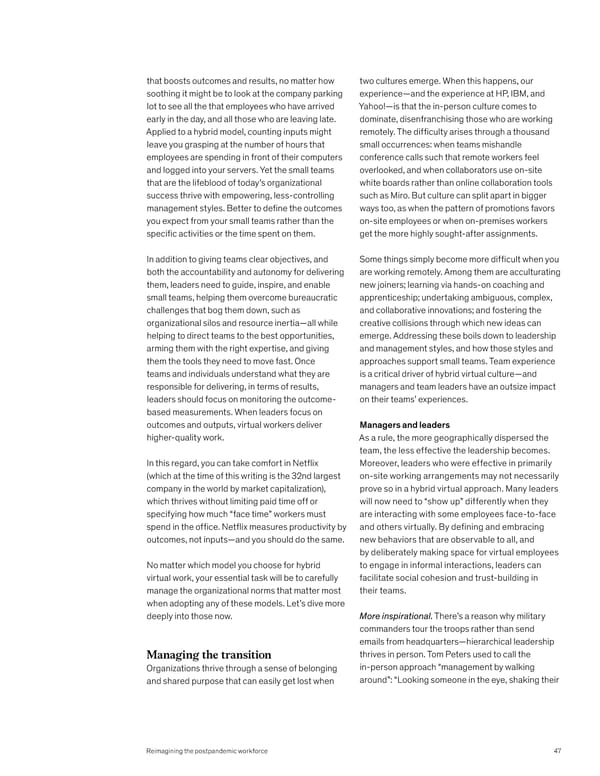that boosts outcomes and results, no matter how two cultures emerge. When this happens, our soothing it might be to look at the company parking experience—and the experience at HP, IBM, and lot to see all the that employees who have arrived Yahoo!—is that the in-person culture comes to early in the day, and all those who are leaving late. dominate, disenfranchising those who are working Applied to a hybrid model, counting inputs might remotely. The difficulty arises through a thousand leave you grasping at the number of hours that small occurrences: when teams mishandle employees are spending in front of their computers conference calls such that remote workers feel and logged into your servers. Yet the small teams overlooked, and when collaborators use on-site that are the lifeblood of today’s organizational white boards rather than online collaboration tools success thrive with empowering, less-controlling such as Miro. But culture can split apart in bigger management styles. Better to define the outcomes ways too, as when the pattern of promotions favors you expect from your small teams rather than the on-site employees or when on-premises workers specific activities or the time spent on them. get the more highly sought-after assignments. In addition to giving teams clear objectives, and Some things simply become more difficult when you both the accountability and autonomy for delivering are working remotely. Among them are acculturating them, leaders need to guide, inspire, and enable new joiners; learning via hands-on coaching and small teams, helping them overcome bureaucratic apprenticeship; undertaking ambiguous, complex, challenges that bog them down, such as and collaborative innovations; and fostering the organizational silos and resource inertia—all while creative collisions through which new ideas can helping to direct teams to the best opportunities, emerge. Addressing these boils down to leadership arming them with the right expertise, and giving and management styles, and how those styles and them the tools they need to move fast. Once approaches support small teams. Team experience teams and individuals understand what they are is a critical driver of hybrid virtual culture—and responsible for delivering, in terms of results, managers and team leaders have an outsize impact leaders should focus on monitoring the outcome- on their teams’ experiences. based measurements. When leaders focus on outcomes and outputs, virtual workers deliver Managers and leaders higher-quality work. As a rule, the more geographically dispersed the team, the less effective the leadership becomes. In this regard, you can take comfort in Netflix Moreover, leaders who were effective in primarily (which at the time of this writing is the 32nd largest on-site working arrangements may not necessarily company in the world by market capitalization), prove so in a hybrid virtual approach. Many leaders which thrives without limiting paid time off or will now need to “show up” differently when they specifying how much “face time” workers must are interacting with some employees face-to-face spend in the office. Netflix measures productivity by and others virtually. By defining and embracing outcomes, not inputs—and you should do the same. new behaviors that are observable to all, and by deliberately making space for virtual employees No matter which model you choose for hybrid to engage in informal interactions, leaders can virtual work, your essential task will be to carefully facilitate social cohesion and trust-building in manage the organizational norms that matter most their teams. when adopting any of these models. Let’s dive more deeply into those now. More inspirational. There’s a reason why military commanders tour the troops rather than send emails from headquarters—hierarchical leadership Managing the transition thrives in person. Tom Peters used to call the Organizations thrive through a sense of belonging in-person approach “management by walking and shared purpose that can easily get lost when around”: “Looking someone in the eye, shaking their Reimagining the postpandemic workforce 47
 What Now? Page 48 Page 50
What Now? Page 48 Page 50